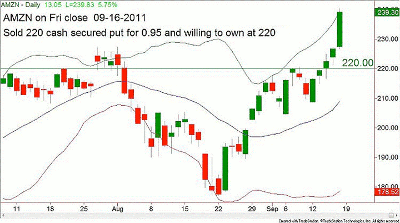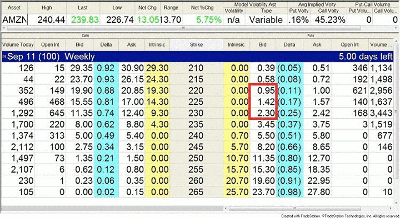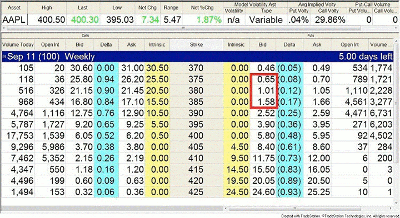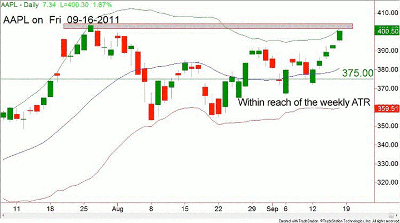These recent trade examples show the important factors to consider when planning and executing a cash-secured put on a desired security.
This MoneyShow.com article is aimed at answering the question of how to properly select a candidate for a cash-secured put. We are going to first look at two different underlying issues and then we will highlight the reasons why one is better than the other. This article builds on the assumption that readers are already familiar with the basic concepts behind using cash-secured puts.
(If you’re new to this type of strategy, you may want to read my previous article from earlier this week on the basics of cash-secured puts.)
Option strategies like these can feel very complex when you first start out, but rest assured that the more you practice and look for good spread trades, the easier it becomes to understand and execute them.
Example 1: Amazon.com, Inc. (AMZN)
To begin, let’s look at an example of a cash-secured put strategy on Amazon.com, Inc. (AMZN). Starting with the chart above, on Friday, Sept. 16, 2011, AMZN closed at $239.30, and we have selected $220 as a horizontal trend line that has acted in the past as both resistance (twice) and support (twice). The higher level of $230 was not selected because the $230 level did not have as many touches as the $220 level did.
The strike price which was selected as the sale candidate was the Sept weekly 220 put. Please notice that between the current price of $239.30 and the sold 220 put, we have $19.30 of protection.
However, to that amount we also need to add the additional credit which we receive by selling the Sept weekly 220 put for 95 cents. Therefore, we have $19.30 of protection, plus the credit of 95 cents, which gives us protection of over $20.
See related: Key Benefits of Weekly Options
Part I - A
Next, let us look at the current Average True Range (ATR) reading. The question becomes which ATR do we really need to pay attention to? Is it the daily or weekly? The Daily ATR is 7.37, while the weekly ATR is 17.85, so taking into account that we are looking at selling the weekly option, it makes perfect sense to take the weekly ATR of 17.85 into consideration.
Hence, let us play out the scenario that AMZN does not go up as anticipated, but comes down in the amount of the weekly ATR of 17.85. This would have AMZN priced around $221, and we as the sellers of the 220 cash-secured put are still not "forced" to buy.
NEXT: Additional Analysis of This AMZN Spread Trade
|pagebreak|Part I – B
An additional way of interpreting the probability of getting the stock at $220 or below, besides the ATR, would be simply by paying attention to the Delta. Delta has many different meanings, but the meaning that we are choosing to focus on is the probability of expiring in the money.
See related: Know Your Option “Greeks”
Observe the transaction listed below and notice the Delta in the brackets. It is positive six because the put was sold; had it been bought, the Delta would be negative.
- Sell to open (STO) one Sept weekly [+0.06] 220 put @ 0.95
- Probability of 220 put expiring out of the money (OTM) is 94%
- We can also figure out our breakeven point (BEP) as follows: BEP = $220 - $0.95, or $219.05
For the rate of return on the investment, we can simply divide the max profit by the risk per share. For one sold 220 put, we are getting 95 cents, while $220 per share is being tied up for the duration of the contract. We are receiving 95 cents and tying up 22,000.
- Rate of Return (ROR) = 0.95/220 = 0.0043
The graphic below shows the AMZN option chain with the intention of pointing out the fact that we could select different strike prices. However, no matter which we select, there are a few things simultaneously taking place. The closer the strike price is to the current price, the higher the premium (and the risk) and the lesser the chance of seeing the put expiring worthless.
For instance, reading the table below from the right to the left (opposite of what we are conditioned to do, I know), we already know that the 220 put gives protection of 20 points, has a Delta of only six, and premium of 95 cents.
Notice how things change as we decrease the amount of space between the sold strike and the current AMZN price at $239.30. For the 225 put, the protection is ($239.30 – $225 = $14.30 + $1.42 of premium) $15.72, which is well within the reach of the weekly ATR.
On the 230 put, things are even worse; hence, the names are assigned as Aggressive for the 230, Moderate for the 225, and Conservative for the 220 put.
NEXT: Trade 2: Cash-Secured Put on Apple, Inc (AAPL)
|pagebreak|Example 2: Apple, Inc. (AAPL)
In a second example, we are considering selling the 380 put. Protection for this position based on AAPL at $400.30 would be $20.30 plus the credit of $1.01, which is over $21.
- Daily Average True Range (ATR) = 7.95
- Weekly ATR = 23.65
- STO one Sept weekly [+0.08] 380 put @ 1.01
- BEP = $380 - $1.01, or $378.99
- Delta is 8, so the probability of the 380 put expiring OTM is 92%
The graphic above is intended for one purpose only, and that is to point out that the sale of the 380 put is well within the ATR reach, so we should simply move to the selection of the lower strike price to achieve greater protection.
The new trade will involve the sale of the 375 put. The numbers are below:
- STO one Sept weekly [+0.04] 375 put @ 0.65
- BEP = $375 - $0.65, or $374.35
- It is outside of the weekly ATR; therefore, it is doable
- Probability of the 375 put expiring OTM is 96%
- ROR = 0.65/375, or 0.00173 in a week
In conclusion, looking at the two examples, it is obvious that AMZN is the better choice because not only do the Delta and ATR values nicely line up and make sense, but also the premium is rich enough to make the trade more worthwhile.
Make sure that before firing the trades, you are certain that the numbers work out. I like to call that TCR, or taking calculated risk.
By Josip Causic, instructor, Online Trading Academy


























